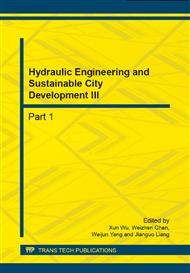p.84
p.88
p.92
p.97
p.101
p.108
p.114
p.119
p.123
The Pattern and Cause Analysis of Tidal Level Fluctuation of the Yangtze River in Nanjing Section
Abstract:
This paper used the Mann-Kendall test, Spearman rank correlation test, Pettitt-Mann-Whitney change-point statistics, and complex Morlet wavelet analysis method to analyze the trend, change-point, and period of the tidal level at Nanjing Station from 1950 to 2012. The results demonstrated that there was a significant increase of annual highest and lowest tidal levels, while the trend of annual average tidal level change was not obvious. Significant mutations existed not only in the term of annual highest tidal level but also in the lowest one: the annual highest tidal level increased by 0.49m after 1972, while the annual lowest one increased by 0.29m after 1982. The period of annual average tidal level, highest one, and lowest one were 10 years, 15 years, and 14 years respectively. The scale of fluctuations in the annual highest tidal level was close to the annual lowest tidal level. The cause analysis of fluctuation indicated that runoff variation was the dominant factor of tidal level change.
Info:
Periodical:
Pages:
101-107
Citation:
Online since:
September 2014
Authors:
Keywords:
Price:
Сopyright:
© 2014 Trans Tech Publications Ltd. All Rights Reserved
Share:
Citation:


